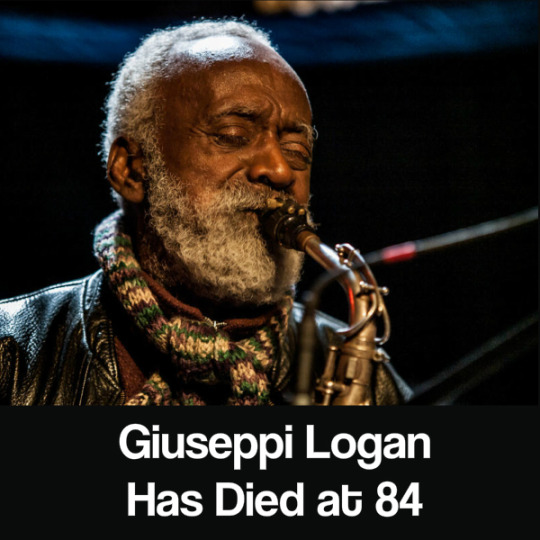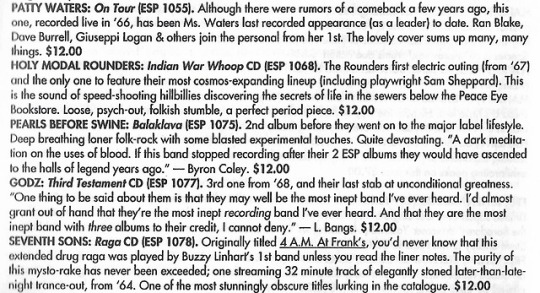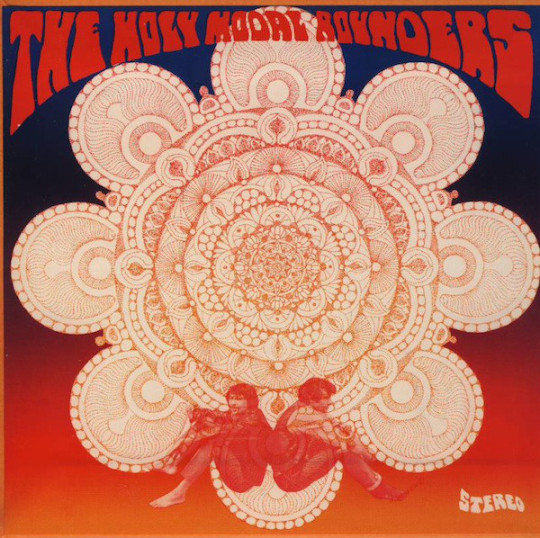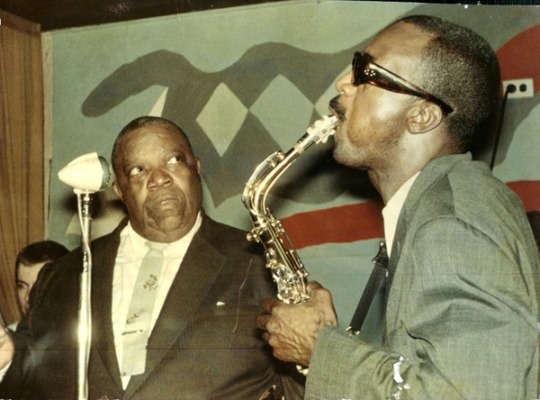#giuseppi logan
Text
cool story about that album session:

3 notes
·
View notes
Text

2010
youtube
youtube
#giuseppi logan#giuseppi logan quartet#tompkins square#music#jazz#modern music#modern jazz#free jazz#dave burrell#francois grillot#warren smith#2010s#2010#youtube#video#videos#CD#Youtube#album cover#green#illustration#ars nova workshop#web archive#elliott sharp#article#writing
2 notes
·
View notes
Text
Peter Brötzmann, Milford Graves, William Parker — Historic Music Past Tense Future (Black Editions Archive)

Photo by Peter Gannushkin / DOWNTOWNMUSIC.NET
Historic Music Past Tense Future by Peter Brötzmann, Milford Graves, William Parker
With his 1967 release For Adolphe Sax, German reed titan Peter Brötzmann, along with bassist Peter Kowald and drummer Sven-Äke Johansson, made an indelible mark as a commanding force with his ferocious tone and caterwauling dynamism. Over the ensuing five-and-a-half decades, Brötzmann has worked with a myriad of international collaborators as soloist, ensemble leader, member of collective units and in one-off meetings. Throughout he’s convened reed/bass/drums lineups with lasting partnerships like his trio with Harry Miller and Louis Moholo-Moholo, William Parker and Hamid Drake, Full Blast with electric bassist Marino Pliakas and drummer Michael Wertmuller or John Edwards and Steve Noble. But there have also been fortuitous meetings with trios like the ones with Barre Phillips and Gunter “Baby” Sommer or Fred Hopkins and Rashied Ali. The music rescued from the vaults on Historic Music Past Tense Future documents a live set by the trio of Brötzmann, Parker, and drummer Milford Graves, an historic meeting on all counts particularly with the paucity of recordings by Graves.
The trio played twice in New York City in the 1980s around the time that Parker and Graves were playing in a trio with Charles Gayle, but they didn’t play again until this 2002 show at CB's 313 Gallery, next door to CBGB. At just over an hour of music split over four sides of this deluxe LP set, the three explode from the start and never flag. While Brötzmann and Parker were playing regularly in various configurations by this point, the addition of Graves on drums incites the group to blazing heights. One is reminded of the ardent propulsive energy that Graves brought to sessions with New York Art Quartet, Giuseppi Logan or Albert Ayler in the 1960s, and here, his choreographed polyrhythms recall those celebrated alliances while drawing on the depth of his sonic research over the subsequent decades.
The improvisation which spans both sides of the first LP kicks off with the braying yawp of saxophone, Parker’s bounding plucked lines and Graves’ limber percussion torrents. Brötzmann’s indelible, full-throated roar thunders along with his usual surging momentum, with phrasing that lunges forward with feints and pummeling blasts. But throughout, one can hear him respond to the drummer’s lithe parries. Parker is, at times, a bit low in the mix, yet his insistent drive creates a gamboling undercurrent, able to lock in to the drummer’s roiling flow with steadfast focus. Graves’ playing is what really amps things though. With double kick drums, bongos, an array of toms and cymbals and snare permanently in the off position, his sense of organic, pulsing energy and orchestrated, interconnected rhythms shapes the group interplay with a penetrating, commanding sensibility. There is an arc to the improvisation, with Parker’s arco solo two-thirds of the way through setting up a section of calm leading in to the final section where Brötzmann’s tawny tarogato and the drummer’s tuned supple mallet playing synch in together, slowly gathering coursing intensity to conclude the piece.
The 17-minute improvisation that fills the first side of the second LP starts with the dancing interplay of Graves and Parker. The drummer’s multi-hued elasticity of pace bucks and swells with spirited élan and Parker responds with supple support. Brötzmann enters on alto three minutes in, with rasping force and the three charge off, locked in to the collective, thrusting flurry. On this piece, the reed player is clearly responding to Graves’ nimble crashes and rolls as his squalling cries ebb and flow with tempestuous vigor. Two-thirds of the way through, a burst of Graves’ vocalizations goads things to gale-force furor which carries through to the end of the piece as the audience bursts into rousing cheers.
The final side begins with Graves’ ritualistic chanting joined in by Parker’s loping doussin gouni and Brötzmann’s muted low-end clarinet musings. Graves introduces thumping, percussive punctuations as the clarinet builds with sinuous potency. Half-way through, Graves jumps in with shuddering drumming and Parker switches to bass, inciting the trio. A lissome section for Graves’ drumming and chanting builds and then cracks open as Brötzmann charges in with torrential tenor and the three ride the breakers of energy, building up densities and then dropping back to let things hurtle toward the final burst of ecstatic potency. Brötzmann and Graves would go on to play several duos together over the next few years, but this would be the last time that the trio would perform together.
Finally, posthumous recordings featuring Milford Graves are starting to appear. Last year saw the release of Sacred Ceremonies with Wadada Leo Smith and Bill Laswell, the highlight of which was a full CD of Smith/Graves duos. Black Editions Archive and co-producer Michael Ehlers have announced that they will be releasing more from Graves’ personal archives including a mid-1970s trio recording with reed players Arthur Doyle and Hugh Glover and a 1991 recording of Graves, Parker and Charles Gayle excerpts of which are online. All of this bodes well for getting Graves’ music the attention it deserves.
Michael Rosenstein
#Peter Brötzmann#Milford Graves#William Parker#Historic Music Past Tense Future#black editions#michael rosenstein#albumreview#dusted magazine#jazz#eremite records#free improvisation
5 notes
·
View notes
Text
Milford Graves: Bijou Teatre 2018

Professor Milford Graves is 79 today! Amazing!
He’s also in a ‘Fight to Keep His Own Heart Beating’ (click to read this unreal story) against stiff heart syndrome, monitoring his own heart rhythms daily in order to try and keep them regular. The incredible full-length documentary about him, Full Mantis, touches on this saga a little bit but mostly focuses on his life, music, and how they intertwine. It’s required viewing.
Cliffs notes via the Full Mantis site if you’re new to Professor Graves:
Graves has performed internationally since 1964, both as a soloist and in ensembles with such legends as Albert Ayler, Giuseppi Logan and Sonny Sharrock. He is a founding pioneer of avant-garde jazz, and he remains one of the most influential living figures in the evolution of the form.
So with this beautiful/heavy context in mind, I’d like to revisit the only time I’ve gotten to see Mr. Graves - the Professor’s mind-expanding 2018 solo performance / clinic / lecture at the glorious Bijou Theatre.
Milford Graves
3.23.2018 @ Bijou Theatre
Knoxville, TN
Milford Graves - percussion, knowledge
streaming | download
4 notes
·
View notes
Photo

Giuseppi Logan, Free-Jazz Multireedist Who Returned Once From Oblivion, Has Died at 84
6 notes
·
View notes
Text
ventidue maggio
Michail Fëdorovič Larionov, Ballerino in movimento, 1915
El desdichado
Io sono il Tenebroso, – il Vedovo, – lo Sconsolato,
Il Principe d’Aquitania dalla torre abolita:
La mia unica Stella è morta, – e il mio liuto costellato
Porta il Sole nero della Malinconia
Nella notte del Sepolcro, Tu che mi hai consolato,
Restituiscimi Posillipo e il mare d’Italia,
Il fiore che piaceva…
View On WordPress
#Agustí Centelles i Ossó#Arthur Conan Doyle#Attilio del Giudice#Carlo Alfano#Charles Aznavour#Domenico Guardi#Gérard de Nerval#Giuseppi Logan#Michail Fëdorovič Larionov#Peter Matthiessen#Richard Wagner#Robert Neumann#Sun Ra#Vance Packard
0 notes
Text
no clue why they retitled this, it’s supposed to be “tabla suite”. I wonder if it was his call, probably a typo (there *is* a tabla)
on this one (& throughout) he plays what the notes call “Pakistani oboe”, I think a zurna?
2 notes
·
View notes
Text
Giuseppi Logan Bio, Age, Wiki, Dies of Coronavirus, Wife, Children, Career
Giuseppi Logan Bio – Wiki
Giuseppi Logan was born on May 22, 1935. He was a jazz musician, originally from Philadelphia, Pennsylvania, who taught himself to play piano and drums before switching to reeds at the age of 12.
Logan died on April 17, 2020, at a nursing facility in Far Rockaway, Queens from COVID-19.
Career
Logan played alto and tenor saxophone, bass clarinet, flute, piano, and…
View On WordPress
#Giuseppi Logan#Giuseppi Logan age#Giuseppi Logan bio#Giuseppi Logan biography#Giuseppi Logan career#Giuseppi Logan cause of death#Giuseppi Logan children#Giuseppi Logan dies#Giuseppi Logan dies of coronavirus#Giuseppi Logan education#Giuseppi Logan Jazz Musician#Giuseppi Logan net worth#Giuseppi Logan singer#Giuseppi Logan songs#Giuseppi Logan wife#Giuseppi Logan wiki#Giuseppi Logan wikipedia#who is Giuseppi Logan
0 notes
Video
youtube
Dance of Satan - Giuseppi Logan Quartet (ESP 1965)
0 notes
Video
youtube
giuseppi logan, don pullen, milford graves -- more (album, 1965)
1 note
·
View note
Photo






“This is the sound of speed-shooting hillbillies discovering the secrets of life in the sewers below the Peace Eye bookstore. Loose, psych-out, folkish stumble...”
ESP reissue reviews by either JIMMY JOHNSON or BYRON COLEY
FORCED EXPOSURE MAIL ORDER LIST #8
June/July 1993
page 17
JIMMY JOHNSON, Proprietor
FORCED EXPOSURE
ESP-DISK’
PATTY WATERS from ESP-Disk’: “In the Spring of 1966, ESP was given a grant by the New York State Council on the Arts, to tour the five colleges in the state with music departments. Artists for this tour included the Sun Ra Arkestra, Burton Greene, Patty Waters, Giuseppi Logan and Ran Blake. Accompanied by an all star backup group from among the participants, Patty's performances resulted in the album, "College Tour", her second recording for ESP-Disk'. The album expands upon the vocal acrobatics that were heard on her first recording, "Sings". "College Tour" won second place for Vocal Recording in Jazz and Pop Magazine in 1970.Patty Waters is internationally recognized as one of the first major avant-garde vocalists. Her ESP-Disk' recordings cemented her reputation as a vocal innovator, and according to liner notes and public opinion, one whose influence extended beyond jazz to Yoko Ono and Diamanda Galas.”
HOLY MODAL ROUNDERS: “The year 1967 proved to be a strong point of the ’60s generation culture and the ever growing New York underground music scene.With the likes of David Peel & the Lower East Side, The Velvet Underground, The Godz, The Fugs, and the Holy Modal Rounders. The music is reflective of the time, and would prove to be the setting of a musical foundation for the group.Steve Weber and Peter Stampfel provided a blithe sendup of musical Americana as they mined this tradition, while introducing outrageous and zany virtuoso turns on acoustic guitar, banjo and violin. Their lyrics and vocals are uniquely their own. Their personalities were profoundly incompatible, like those of Gilbert and Sullivan. They provided the Fugs with their musical underpinnings, and they repeatedly broke up, only to reunite temporarily to record and perform for their loyal following across America. When ESP invited them to record, it was understood that they would take it as far out as they could. Peter Stampfel is outspoken in his dismay over the result, but this view is not shared by Steve Weber.” - Bernard Stollman, owner of ESP-Disk'
R.I.P. TOM RAPP (Pearls Before Swine)
The GODZ Third Testament
SEVENTH SONS’ 4 AM at Frank's T-Shirt via Buzzy Linhart’s bandcamp (really!)
Buzzy Linhart sez about the Raga/4 AM at Frank’s recording (from his bandcamp): “Buzzy Linhart - acoustic guitar (Gibson harp guitar), Serge Katzen - two-side hand drum, James Rock - acoustic guitar , Frank Eventoff - flute (and live sound engineer): “These are the correct credits. This historically significant work has been illegally reissued on CD by small european labels such as ESP Disk, Fallout Records and get back, none have been authorized by any of the Seventh Sons nor their estates and all prior reissues were interrupted mid-jam by the side break. Some reissues called the work "4 AM at Franks", because it is not truly a raga, and all prior version have errors in the credits. Please let this correct the record. Buzzy Linhart has referred to this as "ragoid" and he wants us to keep in mind that all Seventh Sons performances were improvised with no set list and rare breaks. This early recording is a glimpse into what became "Sing Joy" first released on his album "buzzy" (1969, Phillips). The original vinyl "RAGA" and CD reissues include liner notes written by Steve Denaut who was the original bass player for the Seventh Sons when they backed Fred Neil at many gigs in Greenwich Village. Steve went on to be an actor, writer, director educator for stage making immense contributions to the West Coast Rep Theatre.”
Previously on FRR:
...regarding catalogs (which I consistently mispell as “catalogues”): “We never said record catalogues were the equivalent of zines, but we didn’t say they weren’t either. By the mid to late 90’s, when the good zine writ fab was drying up, catalogues served a useful function by stoking consumer desire, which was what the worthy zines did all along. Long before the Aquarius Records, Forced Exposure, Volcanic Tongue, Permanent Records, Goner, Mississippi and similar weekly email lists filled our electronic mail inboxes, we shut ins had the postage paid print catalogue. They were real - and occasionally spectacular.”
youtube
#Forced Exposure#Jimmy Johnson#Byron Coley#ESP-DISK'#1968#1993#catalogs#Patty Waters#The Holy Modal Rounders#Pearls Before Swine#Seventh Sons#The Godz#Tom Rapp
8 notes
·
View notes


